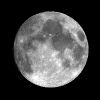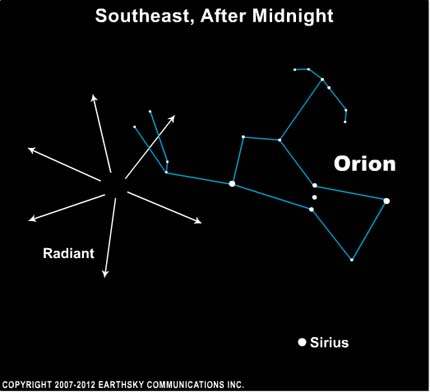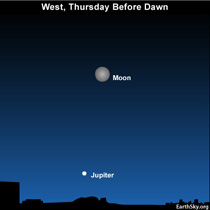Courtesy of EarthSky
A Clear Voice for Science
www.EarthSky.org

 The almost full waxing gibbous moon makes 2010 an unfavorable year for watching tonight’s Orionid meteor shower. However, that same big bright moon near Jupiter will be a sight to behold.
The almost full waxing gibbous moon makes 2010 an unfavorable year for watching tonight’s Orionid meteor shower. However, that same big bright moon near Jupiter will be a sight to behold.
Meteors first. The Orionid meteor shower will probably rain down their greatest number of meteors for 2010 before dawn on Thursday, October 21, 2010. Only diehard meteor enthusiasts will be watching, however, as the meteors are sure to be few and far between – with only the brightest ones visible in the moon’s glare. If you are game, the best time to look for these fast-streaking Orionid meteors is between midnight (1 a.m. daylight saving time) and dawn tomorrow morning, or even a morning or two after that. That time holds true no matter what time zone you are in.
 Now, Jupiter near the moon. Jupiter is just past opposition – when our planet Earth flew between this outer world and the sun. That happened on September 21, and Jupiter was at its brightest. Now a month past opposition, Jupiter is still very bright. It is the brightest object near tonight’s moon. Our chart shows the pair before dawn, when you will find them in the west. However, you can find Jupiter and the moon in the sky tonight from sunset on. They will start out in the east in the evening and move westward as Earth turns beneath the sky throughout the night.
Now, Jupiter near the moon. Jupiter is just past opposition – when our planet Earth flew between this outer world and the sun. That happened on September 21, and Jupiter was at its brightest. Now a month past opposition, Jupiter is still very bright. It is the brightest object near tonight’s moon. Our chart shows the pair before dawn, when you will find them in the west. However, you can find Jupiter and the moon in the sky tonight from sunset on. They will start out in the east in the evening and move westward as Earth turns beneath the sky throughout the night.
The chart at the top of this post shows the radiant point of the Orionid meteor shower. The shower’s radiant is in the northern part of the famous constellation Orion. If you do see a meteor tonight, and you trace its path backwards, you will find that it appears to radiate from this section of the sky.
You can find Orion easily, even in the moonlit glare, because it is the sky’s most distinctive constellation. Orion looks like a big rectangle, with its famous belt of three medium-bright stars marking the middle. These three stars of Orion’s Belt point downward to Sirius, the brightest star in the nighttime sky. Orion is up in the southeast after midnight now, and it is high in the south before dawn. We will have much more to say about Orion in the months to come, because it is definitely the showcase constellation of winter.
Earth crosses the orbit of Halley’s Comet annually in October. Debris from this comet slams into the Earth’s upper atmosphere and vaporizes as its falls. The radiant shows you where orbits of the Earth and Comet Halley intersect. Tomorrow – or Thursday – morning will probably be the best time to look for these meteors, but the moonlit glare will undoubtedly wipe out most of this year’s Orionid meteor display. The moon and Jupiter – and Orion – will probably be the highlight of tonight’s sky, not the Orionid meteors.
Related:
EarthSky’s meteor shower guide for 2010
How do astronomers predict meteor showers?
Written by Bruce McClure
Astronomy Picture of the Day from NASA/JPL
U.S. Naval Observator Astronomical Information center
The York County Astronomical Society